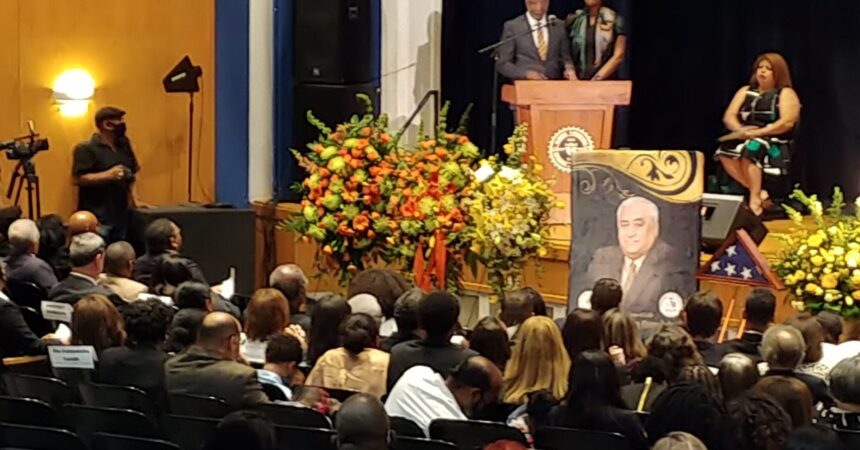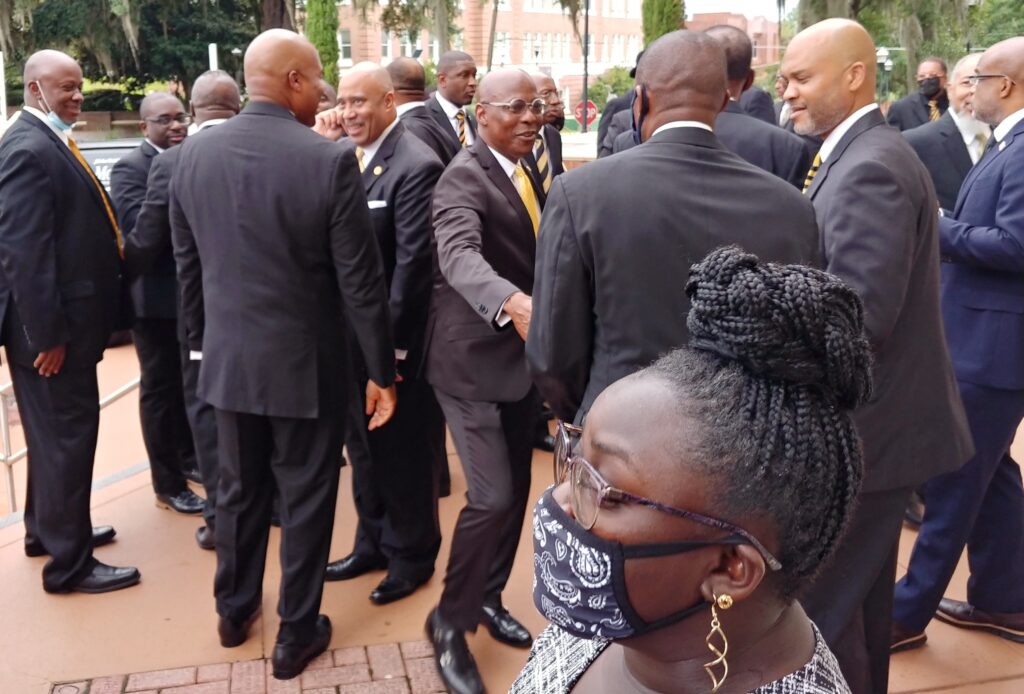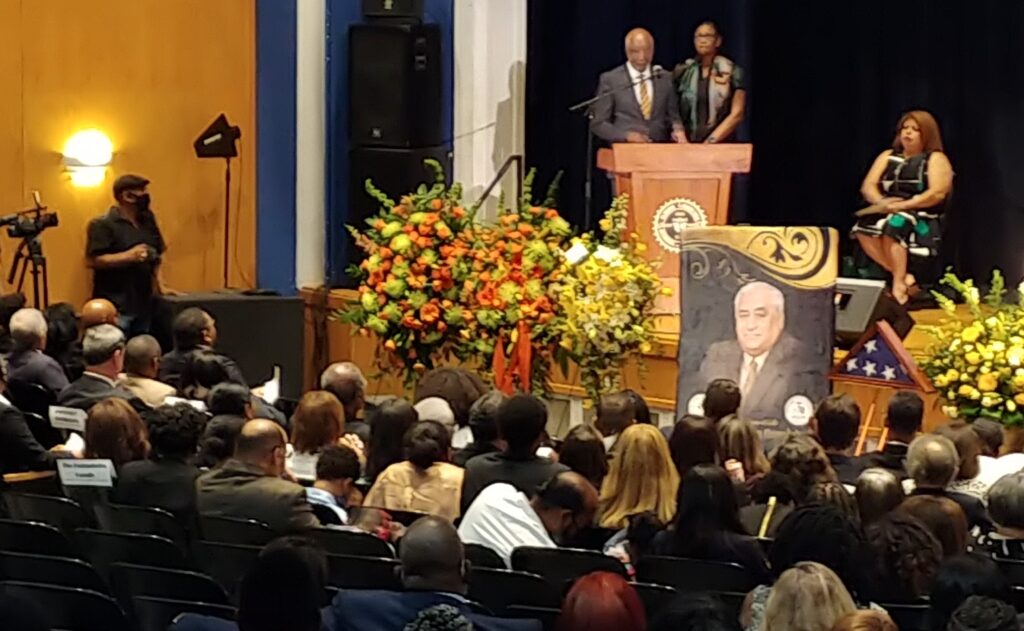
Speakers recall Humphries’ life, commitment to students

Photo by St. Clair

Photo by St. Clair Murraine
By St. Clair Murraine
Outlook staff writer
The memories that Daryl Parks and Henry Lewis have of Frederick S. Humphries ring with similarities, despite how diverse their career paths became after graduating from FAMU.
Their recollections of Humphries, who was president at FAMU from 1985 to 2001, were just two of many stories told during a weekend of memoriam ceremonies for the former president on the campus where he is credited with taking the university through its “Golden Years.”
Humphries died on June 24. He was 84. A memorial last Saturday at the Lawson Center capped three days of tributes for Humphries. They started with a ceremony last Thursday near the eternal flame across from Lee Hall, where a wake was held last Friday evening.
The cities of Tallahassee and Apalachicola, where Humphries was born, presented proclamations during the wake. There is a street in Apalachicola that bears Humphries’ name, said Brenda Ash, mayor pro tem.
“Dr. Humphries never forgot Apalachicola,” she said, “and Apalachicola will never forget Dr. Humphries.”
A memorial service will take place Saturday at Tennessee State University, where Humphries was president before returning to Tallahassee where he spent 16 years as president.
Speakers included Vincent Evans, deputy director of affairs for Vice President Kamala Harris. He brought letters from President Joe Biden and Harris. Congressional representatives Al Lawson, Val Demings and Charlie Crist, a candidate for governor, also attended.
The Marching 100 provided a backdrop, performing the prelude. Rev. RB Holmes presented each speaker who recalled being students or administrators during Humphries’ tenure.
Rev. Gerald L. Durley, pastor emeritus at Providence Missionary Baptist Church, performed the eulogy to cap what was an emotional and sometimes humorous celebration of Humphries.
Throughout the two hours and 30 minutes celebration of Humphries’ life, many had stories about how he changed the lives of students. He more than doubled enrollment from just over 5,000 after taking office.
A lot of what was said was presented during the wake in a video of Humphries biography. At times the audio was drowned out by applause and cheering when Humphries’ achievements were mentioned. One of those times was when it was mentioned that he served two years in the Army as the first Black officer in the Security Agency Intelligence Branch.
The video also featured testimonials by his former employees and students.
Parks, an attorney, was one of the students influenced by Humphries to attend FAMU. He was a two-term president of the Student Government Association, taking the lead in several public issues and gaining support from Humphries.
One particular case recalled by Parks at the Friday Wake involved joining with Bishop Holifield and Reggie Mitchell to present FAMU’s case to the Board of Regents for the reopening of the law school. Parks and other FAMU students were at the forefront leading a rally against former governor Lawton Chiles’ cabinet, a protest against the Gulf War and state budget cuts.
“Everyone may not be on his bandwagon, but Black America, Black Floridians never had a bigger fan than Dr. Humphries,” Parks said. “His whole purpose in life was to create a better environment that our people could have a better chance.”
Parks, who also spoke during the Saturday service, seemingly became emotional at the end. But he didn’t leave before promising to lead an effort to establish a statue for Humphries on the campus, pledging $5,000 to get it started.
The standard that Humphries set led to one of his biggest achievements in 1997 when TIME Magazine/Princeton Review named FAMU “College of the Year.”
Lewis, a 1972 FAMU graduate who became dean of the College of Pharmacy, said Humphries came to FAMU with a vision. It turned out to be one that Lewis had to follow after Humphries left.
Lewis became interim president for one year, starting in January 2002. Monthly administrative meetings with Humphries helped to prepare him for the role in Lee Hall, Lewis said.
“I literally sat at his knees and learned how to be a better administrator,” Lewis said. “When you look back and you see his commitment to this university, you couldn’t help but become equally committed as he was.”
Still, Lewis had his challenges trying to follow the man he’d learned from.
“It was certainly difficult at best, almost impossible to follow a true legend and that’s what Dr. Humphries was; a legend for Florida A&M University,” he said. “His drive, his commitment, his vision for what FAMU could be and should be was what he brought to us in 1985.”
Current president Larry Robinson was one of Humphries’ recruits. He spoke at the Wake and the memorial service, each time pointing out Humphries’ commitment to impacting students who came to FAMU.
One of Humphries’ biggest recruiting tool was a ‘Life Gets Better’ scholarship that he created. But whether that was the way they came or without prompting, the Humphries impact would be felt, Robinson said.
“Their life and the lives of their respective families would indeed get better,” he said.
James Ammons, who also followed Humphries as president, said his predecessor was successful because he could find answers in difficult situations.
“He cracked the code,” Ammons said. “He cracked the code and in doing so he built platforms and programs to elevate the socio and economic status of African Americans and HBCUs. He lived a life that mattered.”
Humphries’ youngest son, Laurence, gave the politicians in the audience messages that he said his dad left for them. He drew laughter when he told Robinson that his father’s wish is for the resumption of the FAMU-TSU football game.
His father’s legacy in place, Laurence Humphries said, “FAMU must produce more African American PhDs in math, computer science, engineering, chemistry and physics.”
TSU president Glenda Baskin Glover likened Humphries to a tree that was planted by rivers of water and grew fruits.
“He represents the tree of leadership, intellect and service,” she said. “Like Dr. Humphries, if we examine a tree closely everything a tree does is for somebody else. Dr. Humphries lived his life helping everybody; everything he did was for somebody else. A tree gives shade for somebody else. A tree bears fruit for somebody else (and) a tree is uprooted and made into homes for somebody else.”







